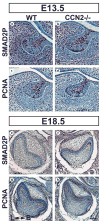Dynamic analysis of the expression of the TGFbeta/SMAD2 pathway and CCN2/CTGF during early steps of tooth development
- PMID: 18089935
- PMCID: PMC2760595
- DOI: 10.1159/000112640
Dynamic analysis of the expression of the TGFbeta/SMAD2 pathway and CCN2/CTGF during early steps of tooth development
Abstract
Background/aims: CCN2 is present during tooth development. However, the relationship between CCN2 and the transforming growth factor beta (TGFbeta)/SMAD2/3 signaling cascade during early stages of tooth development is unclear. Here, we compare the expression of CCN2 and TGFbeta/SMAD2/3 components during tooth development, and analyze the functioning of TGFbeta/SMAD2/3 in wild-type (WT) and Ccn2 null (Ccn2-/-) mice.
Methods: Coronal sections of mice on embryonic day (E)11.5, E12.5, E13.5, E14.5 and E18.5 from WT and Ccn2-/- were immunoreacted to detect CCN2 and components of the TGFbeta signaling pathway and assayed for 5'-bromo-2'-deoxyuridine immunolabeling and proliferating cell nuclear antigen immunostaining.
Results: CCN2 and TGFbeta signaling components such as TGFbeta1, TGFbeta receptor II, SMADs2/3 and SMAD4 were expressed in inducer tissues during early stages of tooth development. Proliferation analysis in these areas showed that epithelial cells proliferate less than mesenchymal cells from E11.5 to E13.5, while at E14.5 they proliferate more than mesenchymal cells. We did not find a correlation between functioning of the TGFbeta1 cascade and CCN2 expression because Ccn2-/- mice showed neither a reduction in SMAD2 phosphorylation nor a difference in cell proliferation.
Conclusion: CCN2 and the TGFbeta/SMAD2/3 signaling pathway are active in signaling centers of tooth development where proliferation is dynamic, but these mechanisms may act independently.
Copyright 2007 S. Karger AG, Basel.
Figures






Similar articles
-
The differential role of Smad2 and Smad3 in the regulation of pro-fibrotic TGFbeta1 responses in human proximal-tubule epithelial cells.Biochem J. 2006 Jan 15;393(Pt 2):601-7. doi: 10.1042/BJ20051106. Biochem J. 2006. PMID: 16253118 Free PMC article.
-
Modulation of the TGFbeta/Smad signaling pathway in mesangial cells by CTGF/CCN2.Exp Cell Res. 2005 Jul 15;307(2):305-14. doi: 10.1016/j.yexcr.2005.03.022. Epub 2005 Apr 22. Exp Cell Res. 2005. PMID: 15950619
-
SMAD3 and SMAD4 have a more dominant role than SMAD2 in TGFβ-induced chondrogenic differentiation of bone marrow-derived mesenchymal stem cells.Sci Rep. 2017 Feb 27;7:43164. doi: 10.1038/srep43164. Sci Rep. 2017. PMID: 28240243 Free PMC article.
-
The role of connective tissue growth factor, a multifunctional matricellular protein, in fibroblast biology.Biochem Cell Biol. 2003 Dec;81(6):355-63. doi: 10.1139/o03-069. Biochem Cell Biol. 2003. PMID: 14663501 Review.
-
A tale of two proteins: differential roles and regulation of Smad2 and Smad3 in TGF-beta signaling.J Cell Biochem. 2007 May 1;101(1):9-33. doi: 10.1002/jcb.21255. J Cell Biochem. 2007. PMID: 17340614 Review.
Cited by
-
The non-canonical BMP and Wnt/β-catenin signaling pathways orchestrate early tooth development.Development. 2015 Jan 1;142(1):128-39. doi: 10.1242/dev.117887. Epub 2014 Nov 26. Development. 2015. PMID: 25428587 Free PMC article.
-
The role of connective tissue growth factor (CTGF/CCN2) in skeletogenesis.Crit Rev Eukaryot Gene Expr. 2011;21(1):43-69. doi: 10.1615/critreveukargeneexpr.v21.i1.40. Crit Rev Eukaryot Gene Expr. 2011. PMID: 21967332 Free PMC article. Review.
-
An atypical canonical bone morphogenetic protein (BMP) signaling pathway regulates Msh homeobox 1 (Msx1) expression during odontogenesis.J Biol Chem. 2014 Nov 7;289(45):31492-502. doi: 10.1074/jbc.M114.600064. Epub 2014 Oct 1. J Biol Chem. 2014. PMID: 25274628 Free PMC article.
-
Differential expression of transforming growth factor-beta1, connective tissue growth factor, phosphorylated-SMAD2/3 and phosphorylated-ERK1/2 during mouse tooth development.J Mol Histol. 2017 Dec;48(5-6):347-355. doi: 10.1007/s10735-017-9733-4. Epub 2017 Aug 19. J Mol Histol. 2017. PMID: 28825193
-
Connective-Tissue Growth Factor (CTGF/CCN2) Induces Astrogenesis and Fibronectin Expression of Embryonic Neural Cells In Vitro.PLoS One. 2015 Aug 4;10(8):e0133689. doi: 10.1371/journal.pone.0133689. eCollection 2015. PLoS One. 2015. PMID: 26241738 Free PMC article.
References
-
- Abdollah S, Macias-Silva M, Tsukazaki T, Hayashi H, Attisano L, Wrana JL. TGFβRI phosphorylation Smad2 on Ser465 and Ser467 is required for Smad2-Smad4 complex formation and signaling. J Biol Chem. 1997;272:27678–27685. - PubMed
-
- Abreu JG, Coffinier C, Larraín J, Oelge-schlager M, De Robertis EM. Chordin-like CR and the evolutionarily conserved extracellular signaling system. Gene. 2002a;287:39–47. - PubMed
-
- Bork P. The modular architecture of a new family of growth regulators related to connective tissue growth factor. FEBS Lett. 1993;327:125–130. - PubMed
-
- Brunner A, Chinn J, Neubauer M, Purchio AF. Identification of a gene family regulated by transforming growth factor-β. DNA Cell Biol. 1991;10:293–300. - PubMed
Publication types
MeSH terms
Substances
Grants and funding
LinkOut - more resources
Full Text Sources
Molecular Biology Databases
Miscellaneous

